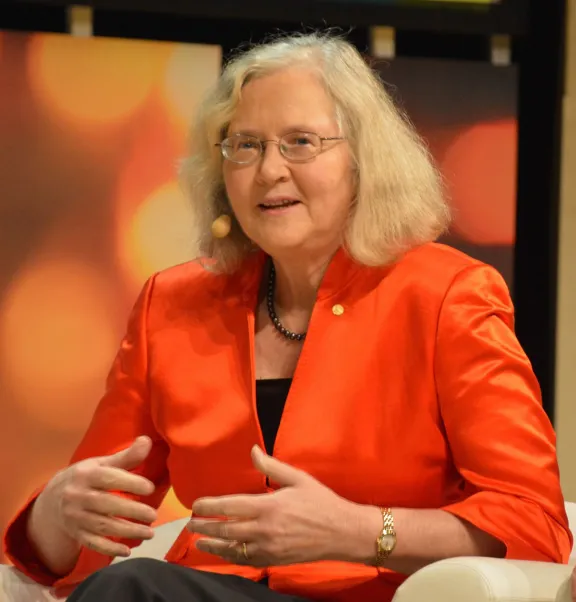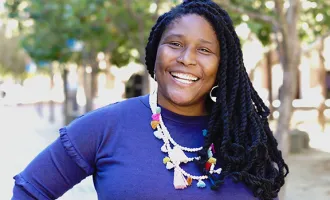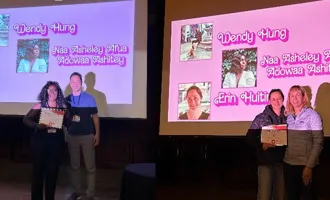
Meeting an Icon
Waiting for the Grey shuttle to Mission Bay, I found myself imagining a situation where I might end up talking to Dr. Elizabeth Blackburn, the scientist and Nobel Laureate who’s reception I was going to attend. Talking to a Nobel Prize winner does not seem like a normal thing to do, so I felt rather perplexed when I saw Dr. Blackburn approach the shuttle stop herself.
After a bit of hesitation, I approached her and introduced myself.
“I hope you don’t mind me saying, but I just find it kind of amusing that you have to take the shuttle to your own reception.”
“Oh I don’t know,” she responded. “Seems like the easiest way. And it gives me a chance to read some papers,” indicating a folder in her bag.
On the bus, Dr. Blackburn sat contemplative, repeatedly pulling out a paper with a prepared speech and looking it over. She alternated this with pulling out research articles and reading them, treating both her own work and the papers with the same critical focus. Her pen would come out once in a while, marking them up.
Elizabeth Blackburn grew up and studied in Australia before moving to California to join the UC Berkeley faculty in 1978. While there, she and her then graduate student Carol Greider discovered the enzyme telomerase in 1984.
Telomerase was an incredible discovery, answering a question that had existed since the identification of the genetic molecule: how does DNA replicate its end regions (its telomeres)? Most of the DNA molecule is replicated by attaching a template just prior to it and then copying the opposing strand; however, there is nowhere to attach a template at the molecule’s ends.
Justifiably, in 2009 Blackburn, along with Greider and Jack Szostak, received the Nobel Prize in Physiology or Medicine for this discovery.
Since then telomeres have transformed from a scientific curiosity to an area of great public interest - telomeres have been implicated in everything from aging to cancer to diabetes. Blackburn even co-authored a 2017 book The Telomere Effect with UCSF Psychologist Dr. Elissa Epel on the subject.
In 1990 Dr. Blackburn moved to UCSF, where she served as Chair of the Department of Microbiology and Immunology until 1999, continuing her research into cellular physiology and DNA. She became famous among the scientific community after being fired from the Bush Administration’s President’s Council on Bioethics in 2004 after she voiced support from embryonic stem cell research.
In 2015 Blackburn left UCSF to become the president of the Salk Institute in La Jolla, a premiere institute of biological and biomedical research.
Her leadership, however, received challenge last year when three senior female scientists sued the institution alleging discrimination and a “hostile environment” in which they received less recognition and fewer opportunities due to their gender. The researchers claimed Blackburn herself had done little to address these issues.
Adding to this trouble was the dismissal of one of their chief scientists Inder Verma, former editor-in-chief of the Proceedings of the National Academy of Sciences, who was accused of helping create this hostile environment. Since then, Verma has been accused of sexual harassment spanning decades.
Last December Dr. Blackburn announced her intentions to leave the Salk Institute and return to UCSF. It remains unclear if the issues there influenced her decision, though it seems difficult to imagine they didn’t.
Standing in front of the crowd at the reception celebrating her return, Dr. Blackburn seemed comfortable. Despite reviewing her speech multiple times on the bus, she spoke without looking at it now.
She led a toast to UCSF, acknowledging the institution’s focus on community engagement and ethics in biology. It was a happy coincidence, she noted, that she returned to the school the same week that she turned 70.
Dr. Blackburn acknowledged that many had asked what she was going to do now that she was back, and she said that she would continue where she left off. Her lab, which remains focused on telomeres, was small but active, and she hoped that she could continue to be a productive member of the scientific community. It was as simple as that.
Without further ado, she thanked everyone for coming and began to walk down the steps as the crowd sang “Happy Birthday.”
Amidst the current controversies in genetic research (https://go.nature.com/2RKmfK1) and the ever-growing number of investigations into discrimination and sexual misconduct in the STEM field, Dr. Blackburn seems to be looking for something less contentious. We can only hope her time at UCSF is truly as simple as conducting cutting-edge research and reading papers on the bus.



